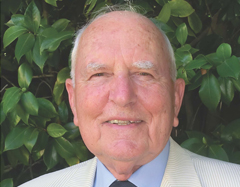 Professor William D. Nix obtained his BS degree in metallurgical engineering from San Jose State College (1959), and his MS (1960) and PhD (1963) degrees in metallurgical engineering and materials science, respectively, from Stanford University. He joined the faculty at Stanford in 1963 and was appointed professor in 1972. As a distinguished faculty member who excelled in both teaching and research, he was named the Lee Otterson Professor of Engineering at Stanford in 1989, served as chairman of the Department of Materials Science and Engineering from 1991 to 1996, and became professor emeritus in 2003. During his tenure at Stanford, he was awarded honorary doctorate degrees from Colorado School of Mines (2001), University of Illinois (2007), and Northwestern University (2012).
Professor William D. Nix obtained his BS degree in metallurgical engineering from San Jose State College (1959), and his MS (1960) and PhD (1963) degrees in metallurgical engineering and materials science, respectively, from Stanford University. He joined the faculty at Stanford in 1963 and was appointed professor in 1972. As a distinguished faculty member who excelled in both teaching and research, he was named the Lee Otterson Professor of Engineering at Stanford in 1989, served as chairman of the Department of Materials Science and Engineering from 1991 to 1996, and became professor emeritus in 2003. During his tenure at Stanford, he was awarded honorary doctorate degrees from Colorado School of Mines (2001), University of Illinois (2007), and Northwestern University (2012).
Professor Nix is an internationally renowned scholar in the field of mechanical behavior of solids, a subject he and his students have researched for more than half a century. He started his research career with a series of important contributions on high temperature creep and fracture of metals in the 1960s. His publications in this area remain among the most important and highly cited in the field. In the mid-1980s, Professor Nix became interested in the then-emerging subject of the mechanical behavior of thin film materials used in microelectronics and microelectromechanical systems (MEMS). This led him to develop many experimental techniques that are now widely used to study thin film mechanical properties including nanoindentation, substrate curvature methods, bulge testing, and the in-situ mechanical testing of very small structures such as micro-pillars and micro-beams. Professor Nix is also well known for his work on the mechanisms of strain relaxation in heteroepitaxial thin films, plastic deformation of thin metal films on substrates, and the growth, characterization and modeling of thin film microstructures. His most recent work has dealt with the mechanical properties of nanostructured materials, size effects on the mechanical properties of crystalline materials (why smaller is stronger), and the mechanical behavior of lithiated nanostructures for use in advanced battery technologies. He has worked on an extraordinarily broad set of technical areas and has helped to define many of the most exciting frontiers in materials research in significant and long-lasting ways.
Professor Nix has received many awards for his distinguished contributions to research, teaching, and service. He is a member of Sigma Xi (1960), the National Academy of Engineering (1987), a member of the National Academy of Sciences (2003), and a Fellow of the American Academy of Arts and Sciences (2002). In 1964, Professor Nix received the Western Electric Fund Award for Excellence in Engineering Instruction, and in 1970, the Bradley Stoughton Teaching Award of the American Society for Metals (ASM) Materials Education Foundation. He received the 1979 Champion Herbert Mathewson Award, and in 1988 was the Institute of Metals Lecturer and recipient of the Robert Franklin Mehl Award of the Metallurgical Society (TMS). In 1995, he received the Educator Award from TMS. He was selected by ASM International to give the 1989 Edward DeMille Campbell Memorial Lecture and in 1998 received the ASM Gold Medal. He gave the Alpha Sigma Mu Lecture in 2000 and received the Albert Easton White Distinguished Teacher Award in 2002 and the Albert Sauveur Achievement Award in 2003, all from ASM. In 1993, he received the Acta Metallurgica Gold Medal, and in 2001, was awarded the Nadai Medal from the American Society of Mechanical Engineers. He was the recipient of the von Hippel Award from the Materials Research Society in 2007, and in 2011 was honored with the Heyn Medal of the German Society of Materials Science. He was elected Fellow of the American Society for Metals in 1978, Fellow of the Metallurgical Society of AIME in 1988, and Fellow of the Materials Research Society in 2011.
Professor Nix is an author or co-author of 450 technical publications and has trained 79 PhD students. His work has been instrumental in stimulating other researchers in the field, with many of his graduate students and postdocs now following in his footsteps as world leaders in mechanical behavior research. He is co-author of the classic text The Principles of Engineering Materials, published in 1973 by Prentice-Hall and used for many years around the world for basic instruction in materials science. His new textbook, Imperfections in Crystalline Solids, was recently introduced by Cambridge University Press as a part of the new Materials Research Society series on the fundamentals of materials science.